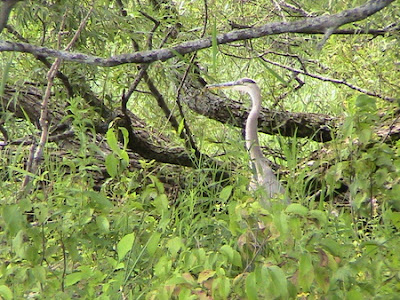The Great Blue Heron really doesn’t amount to much. I learned that back in August 2007. I was making it a daily project to try to explore the burrows that the beavers, who left a pond in 2005, had made during the 5 years they thrived there. So there I was with my head literally in the ground
And when I surfaced I kept seeing a heron that, as herons usually do, didn’t fly away.
When I came back 4 days later I found a dead heron along the shore of the small pond.
I paid attention to how the remains disintegrated and by September 12 was struck by how solid the claws seemed compared to the bare hollow leg bone.
It was as if the whole leg of a human was half the size of the foot. I got the impression that a heron was chiefly feathers, beak and two claws. I assumed the heron that died was a young one, born that year and inept at flying. Paddling around South Bay every summer the only criteria I've had for a heron’s age was the amount of croaking it did when it flew away. But why couldn’t males be more prone to do that, or might old herons finally give up croaking at my tedious presence?
On July 22 this year as I kayaked around the point in the middle of South Bay, I noticed a lone heron in a small marsh along the south shore of the point.
As I paddled closer the heron flew away. On the other side of the point, I admired a large goose family relaxing on the low rocks of the shore,
I was struck by the togetherness of geese and the loneliness of herons. Then when I paddled up the north shore of South Bay, I saw that lone heron standing on a log in the shallow water just off the shore.
I slowly paddled toward it and kept expecting it to fly away, but it stood still
Then when it moved, perhaps reacting to me, it gingerly turned around, getting one foot wet in the process.
Then it jumped with a slight flaps of its wing up into a large dead tree branch arching down into the water.
It looked none too steady, and when it turned around, it almost lost its balance and righted itself with a slight wing flap. As it gathered itself looking over the bay, it seemed to have some regard for how high up it was over the water.
Then it finally bent down and flew off and over the bay, a low flight into the glaring sun and I lost sight of it. I had a video of its escape from me which I prize for showing the elegant clumsiness of a young heron.
True I am making a few assumptions and can’t be sure of the heron’s age, but I have never seen a heron so clumsy. Yet it is still so elegant. Herons skip the cute stage and go right to being beautifully poised.











No comments:
Post a Comment